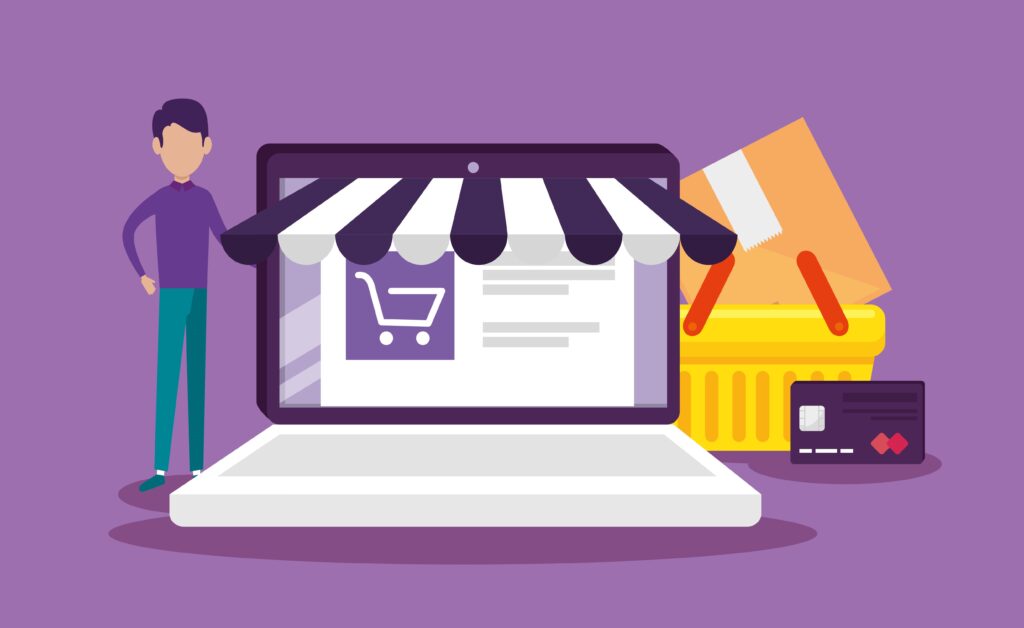You’ve likely heard the term ecommerce tossed around. It’s a concept that has become a fundamental part of everyday life, revolutionizing how we shop, conduct business, and interact with companies worldwide. If you’ve ever bought something online, be it a new pair of shoes, a book, or even groceries, then you’ve engaged in ecommerce. But e-commerce is more than just online shopping; it encompasses a vast array of business activities and transaction types that are worth exploring.
In this comprehensive guide, we’ll dive into what ecommerce really means, the different types that exist, real-world examples, and the numerous benefits it offers for businesses and consumers alike. Whether you’re a budding entrepreneur, a business professional, or simply a curious consumer, this article will give you an insightful understanding of e-commerce and its importance in the modern economy.
What is Ecommerce?
Ecommerce, short for electronic commerce, refers to the buying and selling of goods and services over the internet. This includes transactions conducted on websites, mobile apps, and even through social media platforms. Simply put, e-commerce allows you to purchase products or services without needing to visit a physical store. From digital products like music and eBooks to tangible items like clothing and electronics, ecommerce encompasses all kinds of sales made online. And sometimes e-commerce means a way different to retailers who look to sell online.
In addition to the sales process, ecommerce also involves a variety of other business activities, such as:
- Payment Processing: The secure handling of financial transactions using credit cards, e-wallets, or other online payment methods.
- Order Fulfillment: Managing inventory, shipping, and delivering goods to customers.
- Customer Support: Handling queries, returns, and issues through digital channels.
By leveraging technology, e-commerce has streamlined these processes, making it easier for businesses and consumers to connect, interact, and complete transactions efficiently.
The Evolution of Ecommerce
Ecommerce has a relatively short but highly transformative history. The concept took off in the 1990s with the advent of the internet. Early pioneers like Amazon and eBay began as simple online platforms for selling books and second-hand goods, respectively. Fast forward to today, e-commerce has become a multi-trillion-dollar industry that spans across nearly every sector imaginable.
The rise of mobile technology, improved security measures, and enhanced logistics capabilities have further accelerated ecommerce’s growth. In the early days, e-commerce was primarily limited to desktop computers. Now, thanks to smartphones and mobile apps, you can shop anytime, anywhere—whether you’re sitting at home or on the go.
Key Milestones in the Evolution of Ecommerce
1994: The first secure online transaction takes place on a website called NetMarket.
1995: Amazon and eBay launch, paving the way for modern online marketplaces.
2000s: The rise of digital payment systems like PayPal boosts e-commerce credibility.
2010s: Mobile commerce (or m-commerce) becomes mainstream, with smartphones accounting for a significant portion of online purchases.
How E-commerce Works?
Understanding how ecommerce works involves delving into its fundamental processes and components. Here’s a breakdown of the key steps involved in an e-commerce transaction:
- Online Storefront: The e-commerce process begins with an online storefront, which can be a standalone website or a marketplace platform. This is where businesses showcase their products or services, providing detailed descriptions, images, and pricing.
- Product Selection: Consumers browse the online storefront, searching for products that meet their needs. They can filter results, compare prices, and read reviews to make informed decisions.
- Shopping Cart: Once a consumer selects a product, they add it to their virtual shopping cart. This cart allows customers to compile multiple items for purchase before proceeding to checkout.
- Checkout Process: During checkout, customers provide shipping and payment information. This process often includes creating an account, though many sites also allow guest checkout for convenience.
- Payment Processing: After entering payment information, the transaction is processed through a secure payment gateway. This gateway encrypts sensitive information, ensuring it’s safe from cyber threats. Payment methods may include credit/debit cards, digital wallets (like PayPal or Apple Pay), or even cryptocurrency.
- Order Confirmation: Once the payment is successful, customers receive an order confirmation, including details about their purchase and estimated delivery time. This confirmation may be sent via email or displayed on the website.
- Fulfillment and Shipping: The business processes the order, preparing it for shipment. This involves picking, packing, and labeling the items before handing them over to a shipping carrier. Customers are often provided with tracking information so they can monitor their package’s journey.
- Delivery: Finally, the product is delivered to the customer’s specified address. Many ecommerce businesses strive to offer fast shipping options to enhance customer satisfaction.
- Post-Purchase Support: After delivery, businesses often provide customer support for returns, exchanges, or inquiries. This ongoing relationship helps build trust and loyalty among customers.
Components of E-commerce
Ecommerce is powered by several essential components that work together to facilitate online transactions. Here’s a closer look at the key components of e-commerce:
- Website or Platform: The foundation of any ecommerce business is its website or platform. This is where customers browse products, make purchases, and interact with the brand. e-commerce platforms can be custom-built or created using tools like Shopify, WooCommerce, or Magento.
- Product Catalog: This component includes detailed listings of all available products or services. Each listing typically contains images, descriptions, pricing, and availability. A well-organized product catalog makes it easier for customers to find what they need.
- Shopping Cart System: The shopping cart system allows customers to collect multiple items for purchase. It keeps track of selected products, quantities, and total costs, providing a seamless checkout experience.
- Payment Gateway: A payment gateway securely processes online payments. It acts as a bridge between the customer’s bank and the merchant’s account, encrypting sensitive information to prevent fraud. Common payment gateways include PayPal, Stripe, and Square.
- Inventory Management: Efficient inventory management is crucial for e-commerce businesses. It involves tracking stock levels, managing suppliers, and ensuring timely restocking. Proper inventory management helps prevent stockouts and overstock situations.
- Shipping and Fulfillment: This component deals with the logistics of delivering products to customers. It includes choosing shipping carriers, managing delivery times, and handling returns. Many e-commerce businesses partner with third-party logistics (3PL) providers to streamline this process.
- Customer Relationship Management (CRM): A CRM system helps businesses manage interactions with customers, track sales, and analyze data to improve relationships. It can provide insights into customer behavior, preferences, and purchase history.
- Analytics and Reporting Tools: Ecommerce businesses rely on analytics to track performance metrics, such as website traffic, conversion rates, and sales trends. These insights help inform marketing strategies and identify areas for improvement.
- Security Measures: Given the sensitive nature of online transactions, robust security measures are vital. This includes SSL certificates for encryption, secure payment gateways, and regular security audits to protect against cyber threats.
Types of Ecommerce
Ecommerce isn’t a one-size-fits-all model. Depending on who is selling and who is buying, e-commerce transactions can be classified into several different types. Here’s a breakdown of the most common types of ecommerce:
1. Business-to-Consumer (B2C)
In B2C e-commerce, businesses sell goods and services directly to individual consumers. This is the most common form of ecommerce and includes everything from online retail stores to streaming services.
Example: If you buy a pair of sneakers from an online store like Nike or order a meal kit from Blue Apron, that’s B2C ecommerce.
2. Business-to-Business (B2B)
B2B ecommerce involves transactions between businesses. In this model, companies sell products or services to other companies rather than individual consumers. This type of e-commerce often involves bulk orders and specialized products.
Example: A business purchasing software or office supplies from another company, such as a retailer buying wholesale goods from a manufacturer, falls under B2B e-commerce.
3. Consumer-to-Consumer (C2C)
C2C ecommerce allows individuals to buy and sell goods or services to one another, often through a third-party platform that facilitates the transactions. This type of e-commerce has grown in popularity with platforms like eBay, Craigslist, and Facebook Marketplace.
Example: Selling your used laptop on eBay or buying second-hand clothes from a seller on Poshmark is an example of C2C ecommerce.
4. Consumer-to-Business (C2B)
In C2B e-commerce, individuals sell products or services to businesses. This model is less common but is gaining traction with the rise of influencer marketing, freelancing, and crowdsourcing platforms.
Example: A freelance designer creating a logo for a company on Upwork or a photographer selling stock images to businesses on Shutterstock are examples of C2B transactions.
5. Business-to-Government (B2G)
This model refers to businesses providing goods and services to government agencies. B2G e-commerce is particularly common in industries such as technology, defense, and infrastructure development.
Example: A company supplying computers or software to a government agency would be engaging in B2G ecommerce.
6. Government-to-Citizen (G2C)
Though not traditionally considered ecommerce in the business sense, G2C involves government bodies offering services or information to citizens online. This includes things like paying taxes, applying for permits, or renewing your driver’s license via a government portal.
Benefits of E-commerce
E-commerce has brought numerous benefits to both consumers and businesses. Here’s a look at some of the key advantages:
1. Convenience and Accessibility
One of the biggest benefits of ecommerce is the sheer convenience it offers. With online shopping, you can browse products, compare prices, and make purchases all from the comfort of your home—24/7. There’s no need to adhere to store hours or battle through crowds at a mall. For consumers with busy schedules or those living in remote areas, e-commerce offers unparalleled accessibility.
2. Global Reach
For businesses, e-commerce opens the door to a global marketplace. A local brick-and-mortar store is limited to customers in the immediate vicinity. But with an online store, you can attract buyers from all around the world. Ecommerce breaks down geographic barriers, enabling businesses to scale and reach a much wider audience.
3. Personalized Shopping Experience
Thanks to advancements in technology and data analytics, e-commerce platforms can offer personalized shopping experiences that cater to individual preferences. By analyzing customer behavior, ecommerce sites can recommend products based on past purchases, suggest complementary items, and even provide targeted discounts.
4. Cost Efficiency
Ecommerce often results in lower operational costs for businesses. Without the need for a physical storefront, businesses can save on rent, utilities, and other overhead expenses. Additionally, digital marketing channels—like social media and email campaigns—are often more cost-effective than traditional advertising methods.
5. Faster and Easier Transactions
With the click of a button, customers can complete transactions quickly and securely. E-commerce platforms integrate various payment gateways, allowing you to pay via credit cards, digital wallets, or even cryptocurrencies. The entire process—from selecting a product to making a payment—takes only a few minutes.
6. Scalability
For businesses, ecommerce platforms are highly scalable. Whether you’re a small business just starting out or a large enterprise with established customers, e-commerce allows you to grow your business with minimal friction. You can easily expand product offerings, add more payment options, and improve the user experience to handle increased traffic and demand.
Challenges of Ecommerce
While e-commerce offers many benefits, it also comes with its own set of challenges. Understanding these challenges can help you navigate the digital marketplace more effectively.
1. Cybersecurity Concerns
With the rise of ecommerce comes an increased risk of cyber-attacks, data breaches, and fraud. Protecting sensitive customer data, including payment information, is a top priority for online businesses. Implementing robust security measures like SSL encryption, two-factor authentication, and secure payment gateways is essential to maintain consumer trust.
2. Cart Abandonment
Cart abandonment is a significant challenge in e-commerce. Many potential customers browse online stores, add items to their carts, and then leave without completing the purchase. Reasons for this could include unexpected shipping costs, complicated checkout processes, or simply a change of mind. Reducing cart abandonment often involves optimizing the user experience and offering clear communication about costs.
3. Shipping and Logistics
Managing shipping and logistics can be complex, especially for businesses selling physical goods. Ensuring timely deliveries, dealing with international shipping regulations, and handling returns or lost packages are common issues ecommerce businesses face. Partnering with reliable logistics companies is essential to providing a smooth customer experience.
4. Lack of In-Person Interaction
One downside of e-commerce is the lack of face-to-face interaction. For customers who enjoy personal service or the ability to physically inspect products before buying, ecommerce may feel impersonal. However, businesses can mitigate this by offering virtual customer support, live chat services, and generous return policies.
Popular Ecommerce Platforms
Several ecommerce website platforms or builders provide a foundation for businesses to set up their online stores. Here are a few notable options:
1. Shopify
Shopify is one of the most popular ecommerce platforms, offering businesses of all sizes a user-friendly interface to create online stores. Shopify supports various payment methods, shipping integrations, and marketing tools, making it a versatile option for any business looking to start or grow its e-commerce presence.
2. WooCommerce
WooCommerce is an open-source ecommerce plugin for WordPress, making it an ideal choice for those who already have a WordPress website. It offers extensive customization options and a wide range of plugins to enhance functionality. WooCommerce is particularly popular among small to medium-sized businesses looking to add e-commerce capabilities to their existing sites.
3. BigCommerce
BigCommerce is a robust ecommerce platform that caters to both startups and larger enterprises. It provides a comprehensive set of features, including advanced SEO tools, multi-channel selling capabilities, and built-in marketing tools. BigCommerce is designed to grow with your business, making it a great long-term option.
4. Magento
Magento is an open-source e-commerce platform known for its flexibility and scalability. It’s particularly suited for businesses with large inventories or specific custom requirements. However, Magento can be more complex to set up and manage than other platforms, so it’s often best for businesses with dedicated IT resources.
5. Etsy
Etsy is a unique e-commerce platform focused on handmade, vintage, and craft items. It provides a marketplace for artisans and small business owners to showcase their creations. Etsy is an excellent option for creative entrepreneurs looking to reach a niche audience without building a standalone ecommerce site.
Emerging Trends in Ecommerce
As e-commerce continues to evolve, new trends are shaping the way businesses and consumers interact. Here are some emerging trends to watch in the ecommerce landscape:
1. Mobile Commerce (M-Commerce)
The proliferation of smartphones has given rise to mobile commerce. With more consumers shopping on their mobile devices, businesses need to optimize their e-commerce sites for mobile viewing. This includes ensuring quick loading times, easy navigation, and streamlined checkout processes. M-commerce not only makes shopping convenient but also allows for impulse purchases—perfect for today’s fast-paced lifestyle.
2. Social Commerce
Social media platforms like Instagram, Facebook, and Pinterest are increasingly integrating e-commerce functionalities. This allows users to shop directly through their social media feeds, making the shopping experience more interactive and engaging. As consumers spend more time on social media, businesses can leverage these platforms to showcase products and drive sales.
3. Artificial Intelligence and Chatbots
Artificial intelligence (AI) is transforming ecommerce by enhancing customer experiences through personalization and automation. AI can analyze consumer behavior to provide tailored recommendations, improving the likelihood of conversion. Additionally, chatbots are being used to handle customer inquiries in real-time, offering support and assistance 24/7.
4. Subscription-Based Models
The subscription model is gaining traction across various industries. From meal kits to streaming services, consumers enjoy the convenience of receiving regular deliveries of products or content. This model not only fosters customer loyalty but also provides businesses with predictable revenue streams.
5. Sustainable Ecommerce
With growing awareness of environmental issues, consumers are increasingly seeking out sustainable and eco-friendly products. Businesses that prioritize sustainability in their practices—such as using recycled materials, reducing waste, and offering carbon-neutral shipping—are likely to attract conscientious consumers. Transparency about sourcing and manufacturing processes can also enhance a brand’s appeal.
6. Augmented Reality (AR)
Augmented reality is making waves in e-commerce, allowing consumers to visualize products in their own space before making a purchase. For instance, furniture retailers can use AR apps to enable customers to see how a piece of furniture would look in their home. This technology enhances the shopping experience and helps reduce the uncertainty often associated with online purchases.
Conclusion
Ecommerce has reshaped the way we shop, conduct business, and engage with brands. From its humble beginnings to the vast array of options available today, e-commerce continues to evolve, offering both consumers and businesses exciting opportunities.
Whether you’re a business owner looking to establish an online presence or a consumer enjoying the convenience of digital shopping, understanding e-commerce is crucial in today’s digital age. With its numerous benefits, from convenience and accessibility to global reach and personalization, ecommerce has firmly established itself as a cornerstone of modern commerce.
As you explore this dynamic landscape, keep an eye on emerging trends and innovations that will further shape the future of e-commerce. Embrace the changes and opportunities that ecommerce offers, and you’ll be well-equipped to thrive in this ever-evolving digital marketplace.






1 thought on “What is Ecommerce? Definition, Types, Examples, and Benefits”
You could definitely see your expertise about “Ecommerce” in the work you write. The world hopes for more passionate writers like you who are not afraid to mention how they believe. At all times, follow your heart.